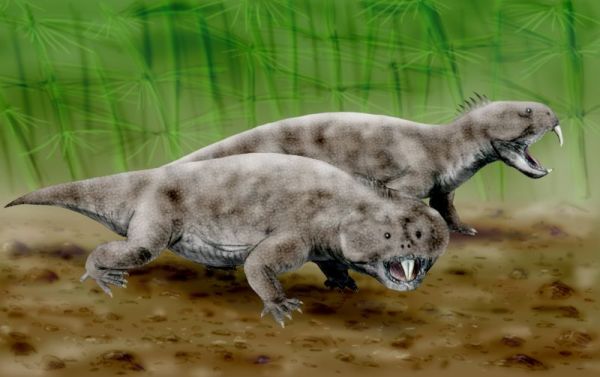
Life reconstruction of the advanced late Triassic rhynchosaur Hyperodapedon huxleyi, late Carnian of India
Artwork by Nobu Tamura, via Wikipedia, GNU Free Documentation/Creative Commons Attribution Share Alike
| Archosauromorpha | ||
| The Vertebrates | Rhynchosauria |
| Vertebrates Home | Vertebrate | Vertebrate |
|
Abbreviated Dendrogram
Diapsida
├─Lepidosauromorpha
│
└─Archosauromorpha
╞═"Protorosauridae"
└─┬?─Choristodera
├?─Chelonii (molecular phylogeny)
├?─Helveticosaurus
└─┬─Rhynchosauria
└─┬─Trilophosauria
└─┬─Prolacertiformes
├─Drepanosauridae
└─Archosauria
|
Contents
Overview |
 Life reconstruction of the advanced late Triassic rhynchosaur Hyperodapedon huxleyi, late Carnian of India Artwork by Nobu Tamura, via Wikipedia, GNU Free Documentation/Creative Commons Attribution Share Alike |
The rhynchosaurs are a group of highly distinctive Triassic archosauromorphs. Early forms, like Mosuchus, were quite lizard-like in appareance, but more derived forms like the ubiquitous genus Hyperodapedon became stocky herbivores about 1.5 meters long, with strong digging claws, beaked heads wider than they were long, and remarkable tooth plates for processing tough plant material. During a brief interval in the Late Triassic (the late Cranian, or, in the "Long Norian" chronology, early Norian), they were the most abundant terrestrial herbivores. The sudden and unexpected demise of such successful animals, and their contemporaries the more conventionally lizard-like Trilophosauria and the ox-sized kannemeyeriid dicynodonts, may or may not have been associated with the extinction of the Dicroidium flora that had characterised much of the Triassic Gondwanan ecosystem MAK120312

|
| Mesosuchus browni reconstruction in left lateral view. From Dilkes (1998) |
Archosauromorpha:: (Trilophosauridae + Prolacertiformes + Archosauriformes)) + *.
Specialized dentition with numerous rows in maxilla & dentary and beak; temporal area greatly expanded latterally (adductor muscles); pig-sized; teeth not replaced, but new rows added. In later forms, rear limbs move under body, astragalus & calcaneum attach & lose articulating surface; tarsus consolidates to simple hinge for fore-and-aft motion. Possible ecological intermediate between dicynodont & dinosaur-dominated faunas.
Links: link (note * are 60% of vertebrates found here); link ichnology).
References: Dilkes (1998). ATW991008.
checked ATW050908, last modified MAK120312
Using this material. All material by ATW is public domain and may be freely used in any way (also any material jointly written by ATW and MAK). All material by MAK is licensed Creative Commons Attribution License Version 3.0, and may be freely used provided acknowedgement is given. All Wikipedia material is either Gnu Open Source or Creative Commons (see original Wikipedia page for details). Other graphics are copyright their respective owners